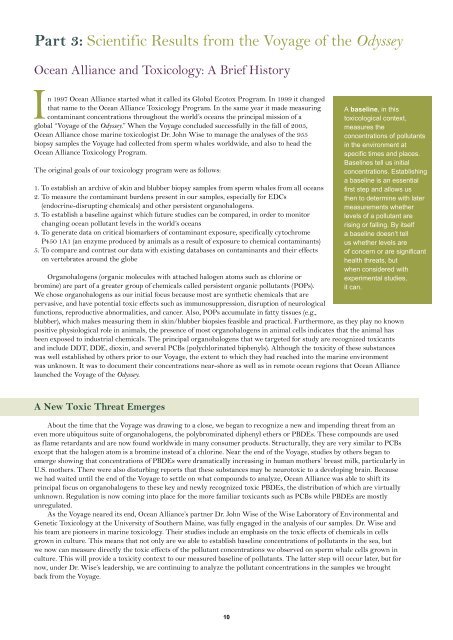Voyage of the Odyssey executive summary - Ocean Alliance
Voyage of the Odyssey executive summary - Ocean Alliance
Voyage of the Odyssey executive summary - Ocean Alliance
You also want an ePaper? Increase the reach of your titles
YUMPU automatically turns print PDFs into web optimized ePapers that Google loves.
Part 3: Scientific Results from <strong>the</strong> <strong>Voyage</strong> <strong>of</strong> <strong>the</strong> <strong>Odyssey</strong><br />
<strong>Ocean</strong> <strong>Alliance</strong> and Toxicology: A Brief History<br />
In 1997 <strong>Ocean</strong> <strong>Alliance</strong> started what it called its Global Ecotox Program. In 1999 it changed<br />
that name to <strong>the</strong> <strong>Ocean</strong> <strong>Alliance</strong> Toxicology Program. In <strong>the</strong> same year it made measuring<br />
contaminant concentrations throughout <strong>the</strong> world’s oceans <strong>the</strong> principal mission <strong>of</strong> a<br />
global “<strong>Voyage</strong> <strong>of</strong> <strong>the</strong> <strong>Odyssey</strong>.” When <strong>the</strong> <strong>Voyage</strong> concluded successfully in <strong>the</strong> fall <strong>of</strong> 2005,<br />
<strong>Ocean</strong> <strong>Alliance</strong> chose marine toxicologist Dr. John Wise to manage <strong>the</strong> analyses <strong>of</strong> <strong>the</strong> 955<br />
biopsy samples <strong>the</strong> <strong>Voyage</strong> had collected from sperm whales worldwide, and also to head <strong>the</strong><br />
<strong>Ocean</strong> <strong>Alliance</strong> Toxicology Program.<br />
The original goals <strong>of</strong> our toxicology program were as follows:<br />
1. To establish an archive <strong>of</strong> skin and blubber biopsy samples from sperm whales from all oceans<br />
2. To measure <strong>the</strong> contaminant burdens present in our samples, especially for EDCs<br />
(endocrine-disrupting chemicals) and o<strong>the</strong>r persistent organohalogens.<br />
3. To establish a baseline against which future studies can be compared, in order to monitor<br />
changing ocean pollutant levels in <strong>the</strong> world’s oceans<br />
4. To generate data on critical biomarkers <strong>of</strong> contaminant exposure, specifically cytochrome<br />
P450 1A1 (an enzyme produced by animals as a result <strong>of</strong> exposure to chemical contaminants)<br />
5. To compare and contrast our data with existing databases on contaminants and <strong>the</strong>ir effects<br />
on vertebrates around <strong>the</strong> globe<br />
Organohalogens (organic molecules with attached halogen atoms such as chlorine or<br />
bromine) are part <strong>of</strong> a greater group <strong>of</strong> chemicals called persistent organic pollutants (POPs).<br />
We chose organohalogens as our initial focus because most are syn<strong>the</strong>tic chemicals that are<br />
pervasive, and have potential toxic effects such as immunosuppression, disruption <strong>of</strong> neurological<br />
functions, reproductive abnormalities, and cancer. Also, POPs accumulate in fatty tissues (e.g.,<br />
blubber), which makes measuring <strong>the</strong>m in skin/blubber biopsies feasible and practical. Fur<strong>the</strong>rmore, as <strong>the</strong>y play no known<br />
positive physiological role in animals, <strong>the</strong> presence <strong>of</strong> most organohalogens in animal cells indicates that <strong>the</strong> animal has<br />
been exposed to industrial chemicals. The principal organohalogens that we targeted for study are recognized toxicants<br />
and include DDT, DDE, dioxin, and several PCBs (polychlorinated biphenyls). Although <strong>the</strong> toxicity <strong>of</strong> <strong>the</strong>se substances<br />
was well established by o<strong>the</strong>rs prior to our <strong>Voyage</strong>, <strong>the</strong> extent to which <strong>the</strong>y had reached into <strong>the</strong> marine environment<br />
was unknown. It was to document <strong>the</strong>ir concentrations near-shore as well as in remote ocean regions that <strong>Ocean</strong> <strong>Alliance</strong><br />
launched <strong>the</strong> <strong>Voyage</strong> <strong>of</strong> <strong>the</strong> <strong>Odyssey</strong>.<br />
A New Toxic Threat Emerges<br />
About <strong>the</strong> time that <strong>the</strong> <strong>Voyage</strong> was drawing to a close, we began to recognize a new and impending threat from an<br />
even more ubiquitous suite <strong>of</strong> organohalogens, <strong>the</strong> polybrominated diphenyl e<strong>the</strong>rs or PBDEs. These compounds are used<br />
as flame retardants and are now found worldwide in many consumer products. Structurally, <strong>the</strong>y are very similar to PCBs<br />
except that <strong>the</strong> halogen atom is a bromine instead <strong>of</strong> a chlorine. Near <strong>the</strong> end <strong>of</strong> <strong>the</strong> <strong>Voyage</strong>, studies by o<strong>the</strong>rs began to<br />
emerge showing that concentrations <strong>of</strong> PBDEs were dramatically increasing in human mo<strong>the</strong>rs’ breast milk, particularly in<br />
U.S. mo<strong>the</strong>rs. There were also disturbing reports that <strong>the</strong>se substances may be neurotoxic to a developing brain. Because<br />
we had waited until <strong>the</strong> end <strong>of</strong> <strong>the</strong> <strong>Voyage</strong> to settle on what compounds to analyze, <strong>Ocean</strong> <strong>Alliance</strong> was able to shift its<br />
principal focus on organohalogens to <strong>the</strong>se key and newly recognized toxic PBDEs, <strong>the</strong> distribution <strong>of</strong> which are virtually<br />
unknown. Regulation is now coming into place for <strong>the</strong> more familiar toxicants such as PCBs while PBDEs are mostly<br />
unregulated.<br />
As <strong>the</strong> <strong>Voyage</strong> neared its end, <strong>Ocean</strong> <strong>Alliance</strong>’s partner Dr. John Wise <strong>of</strong> <strong>the</strong> Wise Laboratory <strong>of</strong> Environmental and<br />
Genetic Toxicology at <strong>the</strong> University <strong>of</strong> Sou<strong>the</strong>rn Maine, was fully engaged in <strong>the</strong> analysis <strong>of</strong> our samples. Dr. Wise and<br />
his team are pioneers in marine toxicology. Their studies include an emphasis on <strong>the</strong> toxic effects <strong>of</strong> chemicals in cells<br />
grown in culture. This means that not only are we able to establish baseline concentrations <strong>of</strong> pollutants in <strong>the</strong> sea, but<br />
we now can measure directly <strong>the</strong> toxic effects <strong>of</strong> <strong>the</strong> pollutant concentrations we observed on sperm whale cells grown in<br />
culture. This will provide a toxicity context to our measured baseline <strong>of</strong> pollutants. The latter step will occur later, but for<br />
now, under Dr. Wise’s leadership, we are continuing to analyze <strong>the</strong> pollutant concentrations in <strong>the</strong> samples we brought<br />
back from <strong>the</strong> <strong>Voyage</strong>.<br />
10<br />
A baseline, in this<br />
toxicological context,<br />
measures <strong>the</strong><br />
concentrations <strong>of</strong> pollutants<br />
in <strong>the</strong> environment at<br />
specific times and places.<br />
Baselines tell us initial<br />
concentrations. Establishing<br />
a baseline is an essential<br />
first step and allows us<br />
<strong>the</strong>n to determine with later<br />
measurements whe<strong>the</strong>r<br />
levels <strong>of</strong> a pollutant are<br />
rising or falling. By itself<br />
a baseline doesn’t tell<br />
us whe<strong>the</strong>r levels are<br />
<strong>of</strong> concern or are significant<br />
health threats, but<br />
when considered with<br />
experimental studies,<br />
it can.


